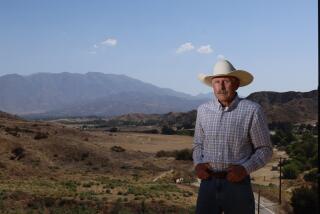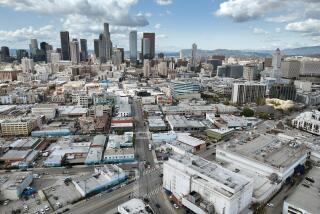Plans for Planting Another Suburb : Growth: Santa Clarita Valley development would cover 19 square miles and house 70,000 people. Officials and environmentalists think they can soften its impact, but they know it’s only one of several projects to come.
Nearly 30 years ago, they took onion fields and planted a suburb called Valencia, at the time the largest subdivision in Los Angeles County history.
Now, Newhall Land & Farming Co. wants to transform a 19-square-mile Santa Clarita Valley tract peppered with oil wells and cattle into a community of 70,000 residents.
With nearly 25,000 homes, 10 schools, six shopping centers and a business park, the development would surpass even the original Valencia project.
It would be about half the size of the city of Santa Clarita and about three times larger than San Fernando or Agoura Hills.
But it is only the latest of several housing projects around the state that are lining up like supertankers at a port, ready to capitalize on the end of the recession.
The project, designed to be built in five phases over a 25-year period, has sparked worries about traffic and other environmental impacts. Concern is heightened because Southern California’s largest remaining wild river, the Santa Clara, flows through the site west of Six Flags Magic Mountain and is home to two federally designated endangered species.
The sprawling Newhall Ranch project would straddle California 126 and fill in a five-mile gap of open space between the amusement park and the Ventura County line. Ventura County officials fear that the suburban sprawl would eventually spill across the line into the bucolic farmlands of the Santa Clara River Valley, since the developer owns another 15,000 acres there.
But even environmentalists who oppose the project concede that the Los Angeles County Board of Supervisors and at least five other state and federal agencies are likely to approve the stack of permits that the developer needs to proceed.
Just announced by company officials, the long-anticipated project is beginning to wend its way through a three-year approval process in Los Angeles County.
“We know the development will undoubtedly go through in some form,” said Ron Bottorff, chairman of Friends of the Santa Clara River. “The best we can do is to reduce the impact.”
Working for Newhall Land is its reputation as developer of the carefully planned Valencia community, and its assertions that it will do all it can to make Newhall Ranch a model of environmentally sensitive development.
“We did nationwide surveys and we found that people want to live close to nature,” said James M. Harter, a senior vice president of Newhall Land. “People are tired of concrete and urban sprawl.”
Newhall Ranch would be made up of five villages linked by a network of roads the company plans to build, including extensions of Chiquita Canyon Road, Magic Mountain Parkway, Valencia Boulevard and San Martinez Grade. Plans also call for California 126, which the state Department of Transportation already intends to widen to four lanes, to be widened to six lanes along a four-mile stretch west of the Golden State Freeway.
The company has offered to set aside 5,400 acres of open space--or 45% of the property--in the southern corner of the project. Mostly impractical for development, the hilly land is part of an area recognized as ecologically sensitive by Los Angeles County. It would be reserved for hiking trails and a few estate lots, Harter said.
Company officials have vowed not to pave over any part of the 100-mile-long Santa Clara River, critical habitat for the least Bell’s vireo, an endangered songbird, and the last refuge of the unarmored three-spined stickleback, a tiny fish.
Under a plan filed with the U.S. Army Corps of Engineers, Newhall Land would preserve the Santa Clara River’s natural soft bottom and add materials to riverbank sections where erosion occurs. That is considered preferable to putting in concrete channels, which reduce the chance of flooding but speed up water flow, scouring the riverbed farther downstream, disrupting river wildlife and prohibiting water from seeping into the ground.
“It would appear they’re taking the sensitive way to go,” said Dave Vannatta, a field deputy to Supervisor Mike Antonovich, who represents the area.
But some environmentalists plan to argue that no structures should be allowed in the river’s flood plain, so there will be less pressure in the future to alter its natural state to protect buildings. They are pushing the Army Corps of Engineers to require a full environmental report of the company’s plans instead of accepting a less thorough environmental assessment that has already found no significant impact.
The traffic impact of the project also troubles Santa Clarita officials, who founded the city six years ago out of concern that unbridled building was outpacing the growth of public services in the area.
“How many more people can this valley hold?” asked Councilwoman Jan Heidt, pointing out that the Santa Clarita Valley was the fastest-growing region in the county before the recession hit. “The impact is going to be just tremendous.”
*
Newhall Land officials said they could not estimate the amount of traffic the project would generate on California 126, the Golden State Freeway and already congested local roads. But they minimized the effects, saying many Newhall Ranch residents would work in local business parks being built in the area.
Newhall Land’s environmental studies will not be completed for months, but it is certain that the impact of the new project will be felt in Ventura County.
As the closest Ventura County city to the new community, Fillmore will probably feel its effect most heavily. Some city residents say they are looking forward to the groundbreaking because it may help Fillmore emerge as a tourist destination.
But Ventura County officials said the development would eventually create enormous pressure on the county to alter its strict policies limiting construction in unincorporated areas separated from existing cities.
Officials note that Newhall Land is involved in a 10-year process of removing all of its unincorporated Ventura County acreage from a state farmland conservation program.
“I think we need to be very concerned about this project’s impact on Ventura County,” said Maggie Kildee, county supervisor for the Santa Clara Valley communities of Piru, Fillmore and Santa Paula.
Newhall Land executives say they simply want to remove government restrictions from their land and have no development plans for their Ventura County holdings, which stretch westward past Piru seven miles into the county.
“I think their fears are unfounded,” Harter said. “The world changes. I don’t know what the world will be like 25 years from now. But at the present time, we have no plans for development in Ventura County.”
Newhall Ranch alone would not be completed until 2032, Harter said.
Although the real estate market is still soft, Newhall Land is just one of several developers around the state attempting to obtain approval for huge projects in anticipation of the end of the downturn, said Bill Fulton, publisher of the California Planning and Development Report. For instance, in San Diego County, a developer plans to build a huge housing project on the 23,000-acre Otay Ranch, he said.
“The thing that’s interesting to me is that Newhall Land waited so long to do this,” Fulton said. “It’s evidence of how incredibly slow and late L.A. is in coming out of this recession compared to Northern California and San Diego.”
Reflecting the depressed housing market, Harter said more than half of the housing in Newhall Ranch would be attached owner-occupied and rental housing, such as condominiums, townhouses and apartments.
The Newhall Ranch Project Projected population: 70,000 Size: 12,000 acres. Number of units: 24,700, 55% of which will be attached. Open space; 5,400 acres. Neighborhood parks: 170 acres. Other amenities: A lake, 200-acres business park and golf course. Schools: One high school, one middle school and eight elementary schools. Projected completion date: 2023, 25 years after construction begins.
More to Read
Sign up for Essential California
The most important California stories and recommendations in your inbox every morning.
You may occasionally receive promotional content from the Los Angeles Times.










